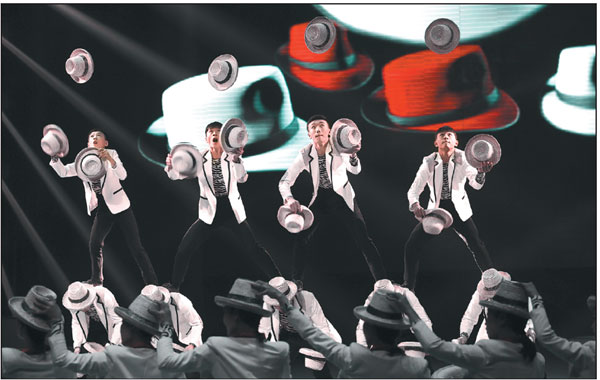Feats of wonder
The 10th China Acrobatics Golden Chrysanthemum Awards were held in Shandong province, and the competition showed that Chinese acrobatics is still going strong. Chen Nan reports.
It is the moment the audience gives a collective gasp of astonishment as Wei Sina, a 16-year-old acrobatic performer, does the splits balanced upside down on one hand on a rotating 3.5-meter high installation.
Suddenly she twists her body as if about to fall and the audience gasps again, this time in shock. But slowly, she stretches her body and poses with her feet pointing to the high ceiling; the audience responds with thunderous applause.
Titled Wings, the 15-minute performance features Wei playing the role of a little bird trying to fly high in heavy rain.
"I am satisfied with my performance because I finished all the movements without any fault. It's a breakthrough for me," says Wei with a deep breath.
Wei, who was born and grew up in Nanning, capital of the Guangxi Zhuang autonomous region, started practicing acrobatics at age 6, and she has already won a number of national awards. She is a performer with the Guangxi Acrobatic Troupe in Nanning.
Wings was one of the 30 performances that made it to the final round of the 10th China Acrobatics Golden Chrysanthemum Awards. Launched in 1987, the competition is held every three years and is the highest award for acrobatics in the country.
This year's competition was held in Penglai in Shandong province from Sept 16 to 21, with more than 28 Chinese acrobatic troupes, featuring over 500 acrobats in total, presenting dazzling, fresh choreographic pieces.
"We've selected 30 programs from hundreds of programs. They represent the highest level of China's acrobatics," says Wang Rengang, secretary-general of the China Acrobats Association, a governmental organization focusing on promotion and development of Chinese acrobatics, founded in 1981.
Since 2005, the China Acrobats Association has initiated a number of plans to revive the traditional art form, including giving financial support to acrobatics troupes, lowering ticket prices and offering the troupes more opportunities to perform both at home and abroad.
"Acrobatics has a long history in China. It is a family entertainment that crosses borders. We've taken China's acrobatics troupes to perform and compete overseas, and they have received warm feedback and lots of awards," Wang says.
Wang says that the history of acrobatics in China dates back to the Tang (618-907) and Song (960-1279) dynasties, but like many traditional Chinese art forms, acrobatics faced a decline with the challenges from contemporary entertainments.
"It takes at least five years to train a new actor to a professional level. So lots of young people give up the idea right at the beginning, which has led to a lack of talent," Wang says.
And for young acrobats like Wei, it's not easy to take the first step.
"I cried for a month in the beginning because it was painful and boring to practice the movements over and over again," says Wei, whose parents run their own business in Nanning. "My parents sent me to the troupe because they thought acrobatics is a visually beautiful art and the job is stable. Now, I am used to the intensive training and despite the hardship, I feel content when I finish a hard move."
Similar to Wei, acrobat Zhang Jianan of the Shandong Acrobatic Troupe started practicing acrobatics from a young age and didn't like it until she made her debut onstage when she was 15.
During the 10th China Acrobatics Golden Chrysanthemum Awards, Zhang, along with 32 other acrobats from the troupe, performed a piece, choreographed by US choreographers Patti Colombo and Shanda Sawyer. With remixes of Michael Jackson's hits, the actors juggled straw hats with great speed.
"I thought about giving up because my main focus was high altitude acrobatic skydiving, which was frightening and caused lots of physical pain," says Zhang, 31, who came from Rizhao, Shandong province. In four years, she will retire from the stage and become a coach.
Despite those complaints, Zhang says that she enjoys the freedom and self-expression of the art form.
Wang Xiaoying, the president of Beijing Acrobatic Troupe, points out that unlike traditional acrobatics, which mainly involves actors demonstrating jaw-dropping physical skills, the art form has now been combined with other elements, such as dance and theatrical techniques such as lighting, 3-D projections and so on, to satisfy the tastes of modern audiences.
The growing awareness of the physical demands on acrobats, especially the younger ones, has also led to great changes in the way the acrobats train.
"Now, our training employs scientific approaches, which are efficient and healthy," says Wang Xiaoying. "The performing life of acrobat, like that of many other athletes, is very short. In the past, acrobats retired at 25 years old. Now, we don't bother to set an age limit. As long as they want to perform onstage, we'll let them stay."
In 1957, a group of acrobats, who had been performing in Tianqiao, a district in downtown Beijing that was once a haven for folk arts, founded the Beijing Acrobatic Troupe.
In 1995, Beijing Acrobatic Troupe presented a diabolo act, which won a gold medal at Paris' Festival Mondial du Cirque de Demain (The World Festival of the Circus of Tomorrow). The following year, this act was presented by Cirque du Soleil, which led to a long association with the Canadian circus.
During the 10th China Acrobatics Golden Chrysanthemum Awards, the troupe brought the diabolo act back with new choreography, new music and displaying traditional techniques.
Celebrating its 60th anniversary this year, the Beijing Acrobatic Troupe invited four retired acrobats back to train the young actors.
"The four artists are in their 70s and 80s and they spent their entire lives practicing their technique, such as playing diabolo and doing contortions. We invited them back because these techniques are not seen onstage nowadays," says Wang Xiaoying. "Given that the demand for traditional culture is growing in the country, there is a good reason for reviving the old acrobatic skills."
Contact the writer at chennan@chinadaily.com.cn
|
Acrobats from Shandong Acrobatic Troupe juggle straw hats and dance in Michael Jackson's style, in a piece choreographed by US choreographers Patti Colombo and Shanda Sawyer. The performance wins over the audience with its blending of elements Chinese and Western, traditional and modern. |


 Shandong Culture and Tourism Consumption Season
Shandong Culture and Tourism Consumption Season Culture, tourism sectors pick up in Shandong as epidemic wanes
Culture, tourism sectors pick up in Shandong as epidemic wanes

